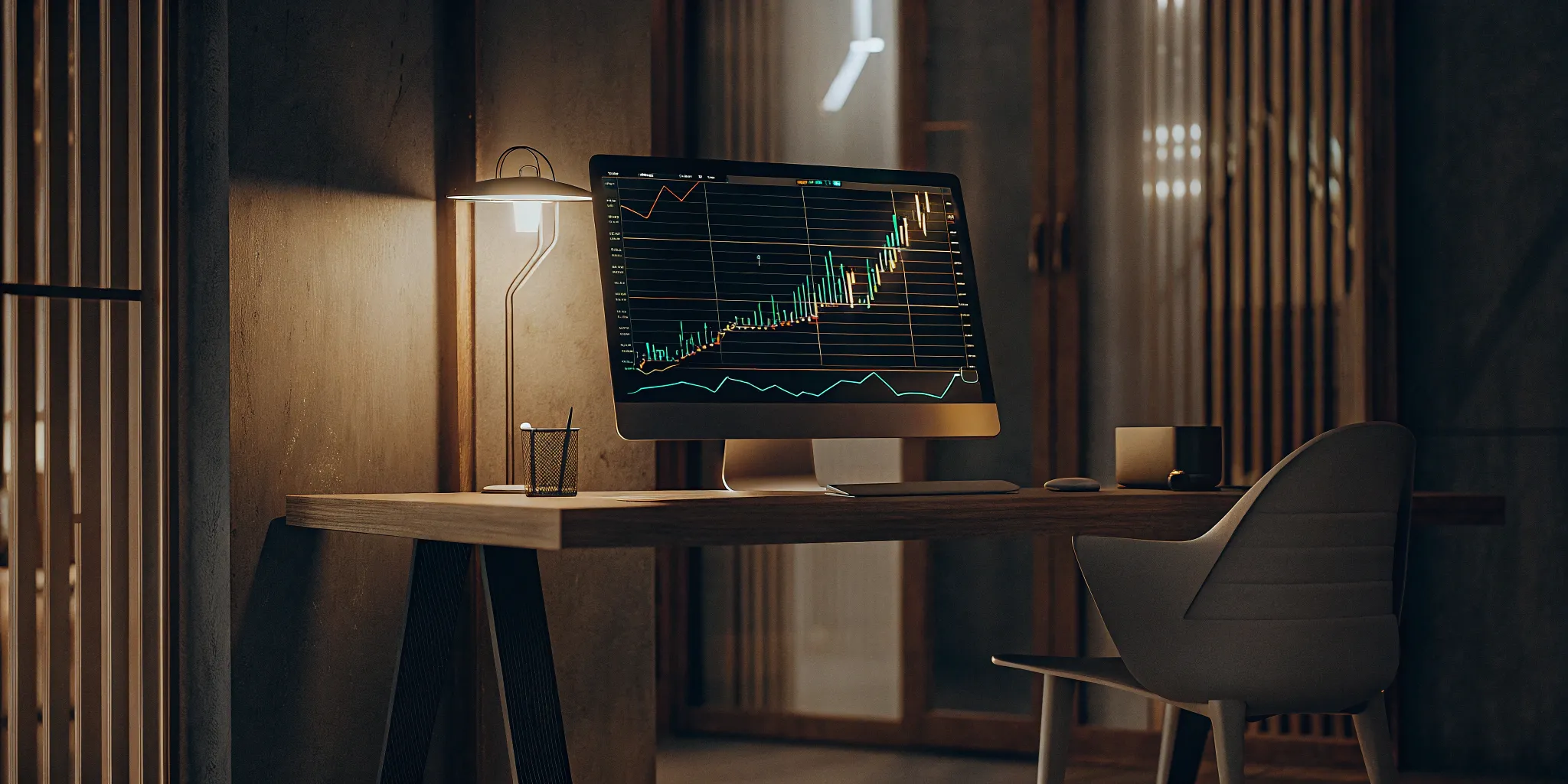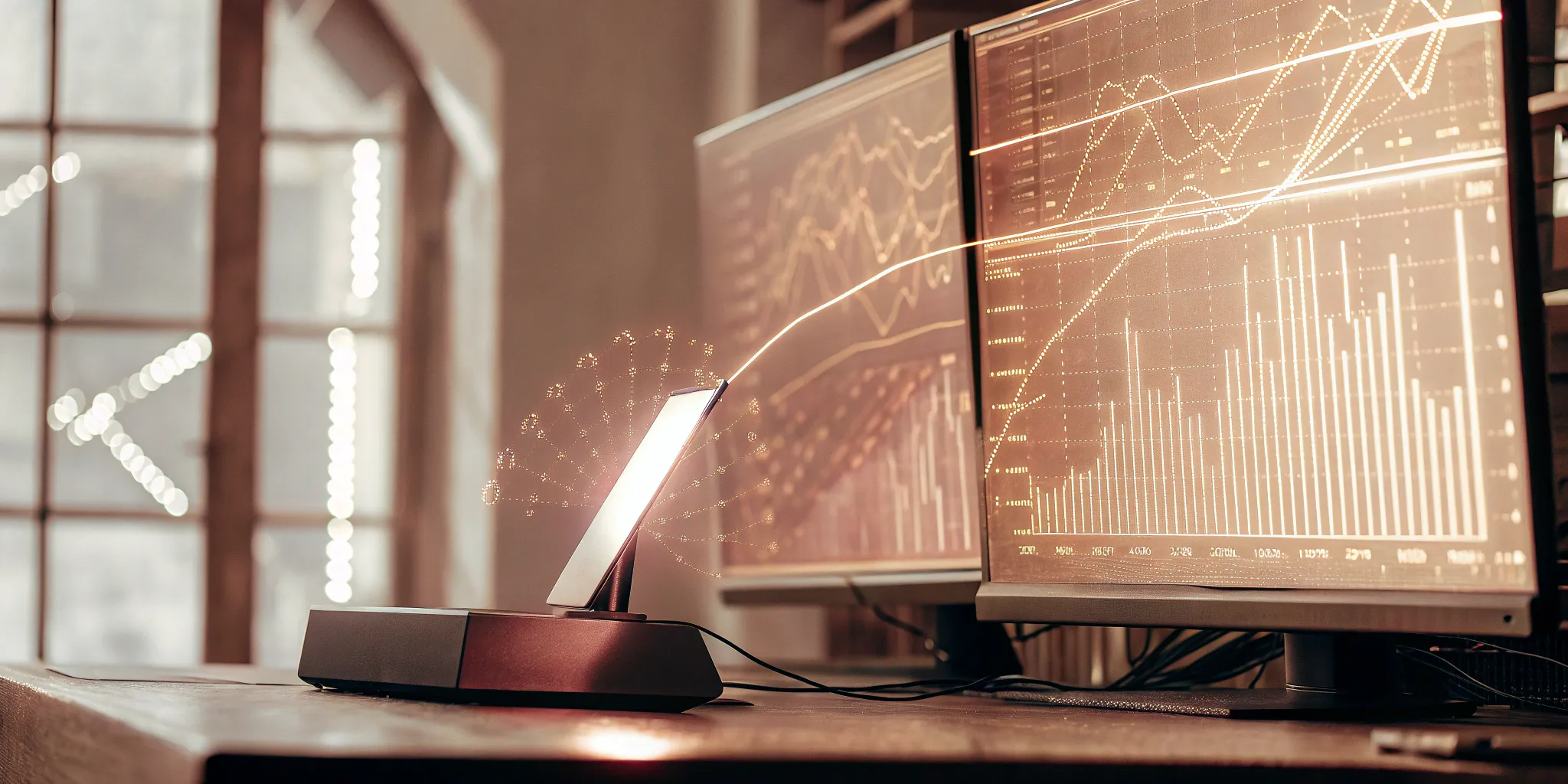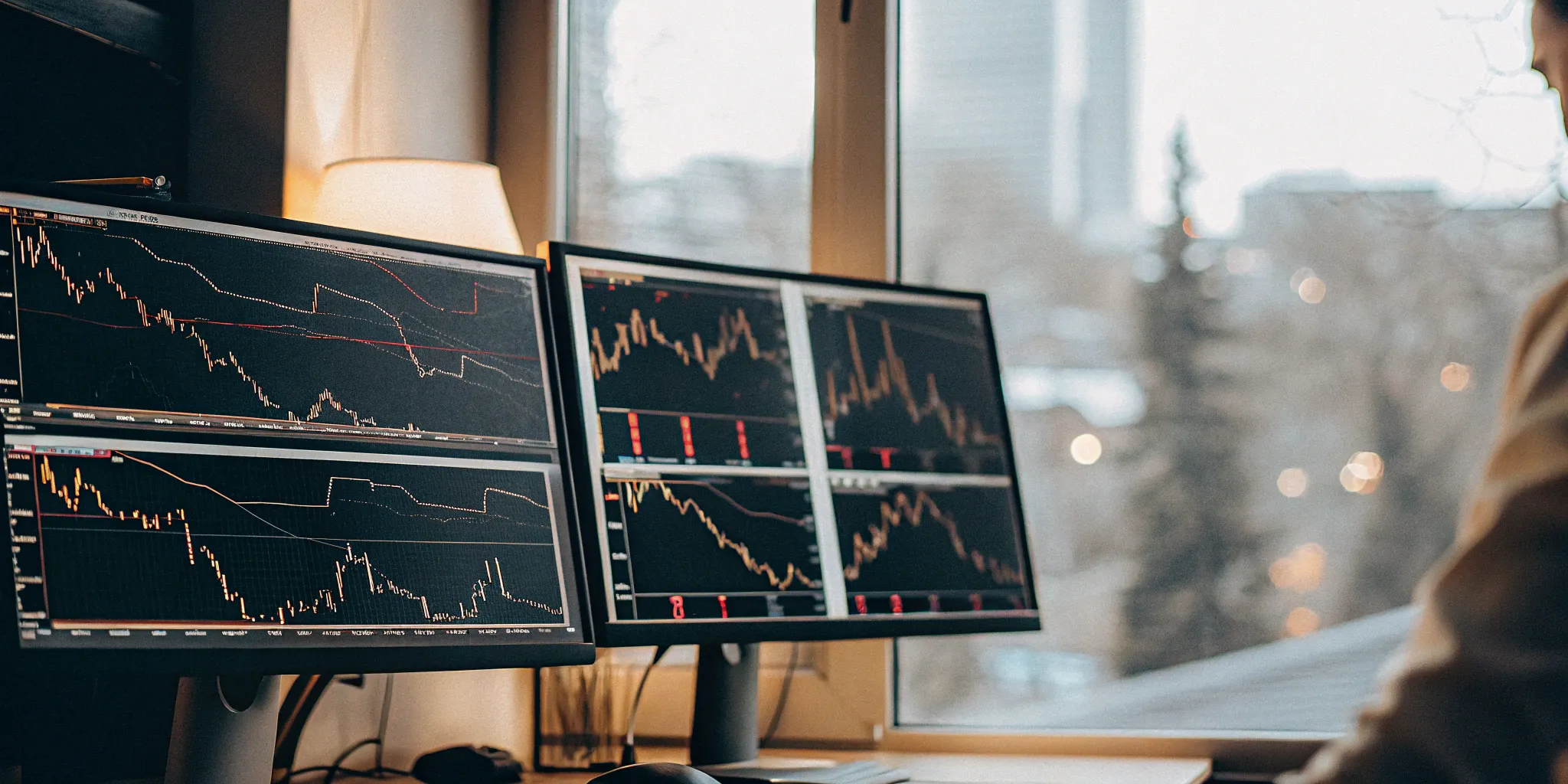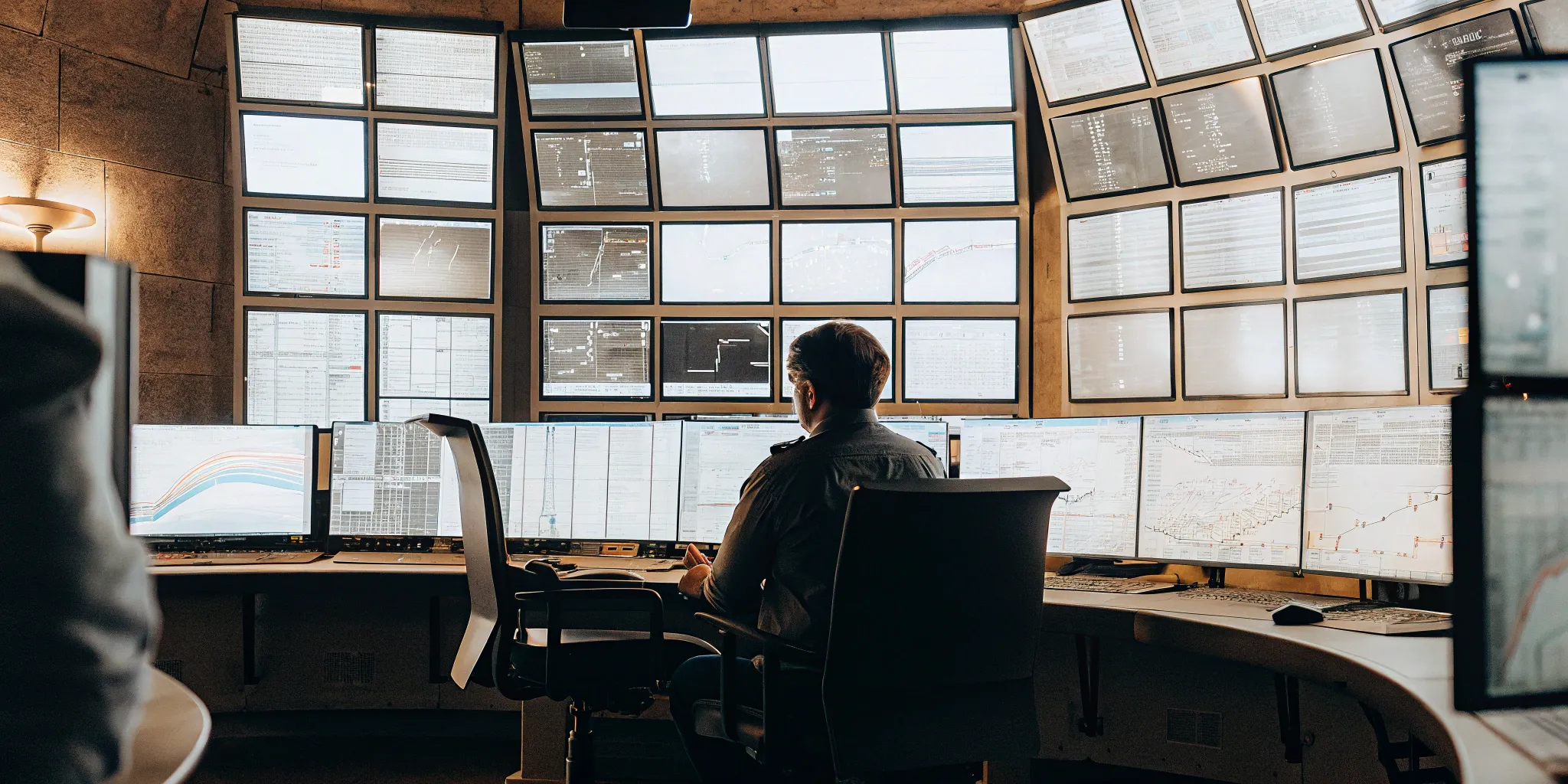The financial markets are dynamic, with countless factors influencing price movements every second. Keeping up with this information flow and making timely decisions can feel overwhelming. An ai trading application is designed to tackle this complexity head-on. Using advanced algorithms, these platforms sift through enormous datasets, from economic indicators to social media sentiment, searching for predictive signals and potential trading opportunities. The goal is to provide you with an edge by automating sophisticated analysis and even trade execution. This technology isn’t just for large institutions anymore; it’s becoming a valuable asset for individual traders looking to refine their approach and make more informed choices.
Key Takeaways
- Leverage AI for smarter trading: These applications analyze market data, automate trades, and manage risk, allowing for more objective and data-driven investment choices.
- Choose your AI app wisely: Start by defining your trading goals and experience, then compare app features like backtesting and automation to find one that truly supports your approach.
- Partner with AI, don’t just delegate: Use AI for its analytical power and execution speed, but remember your strategic input and oversight are key to guiding its success and aligning it with your financial vision.
What Are AI Trading Applications?
So, what exactly are AI trading applications? Think of them as incredibly smart software designed to take on the heavy lifting of trading. These aren’t just simple calculators; they use advanced artificial intelligence and machine learning to sift through enormous amounts of market data. This data can include everything from historical price charts and trading volumes to breaking financial news and even social media sentiment. Based on this comprehensive analysis, they can identify potential trading opportunities, help you build investment portfolios, and even execute trades automatically without you needing to click a single button. The core idea is to make well-informed investment decisions, often faster and with more data points than a human could manage alone.
This technology is all about using data-driven insights to refine your trading approach. These applications are becoming increasingly popular because they offer a way to approach the markets with a level of precision and speed that was previously out of reach for many. They can process complex information in fractions of a second, looking for subtle patterns or signals that might indicate a good time to buy or sell. For anyone looking to get involved in trading, understanding these tools is a great first step. They represent a significant shift in how investment strategies can be implemented, moving towards a more automated, analytical, and potentially more consistent process. It’s about leveraging the power of AI to make smarter, faster decisions in the dynamic world of finance.
How Trading Technology Evolved
Trading has come a long way from crowded exchange floors and shouted orders. The journey of trading technology has been one of constant innovation, leading us to today’s sophisticated AI trading systems. Early electronic trading certainly sped things up, but AI takes it to another level entirely. These modern systems can analyze historical market data, keep an eye on breaking news, and even gauge social media sentiment to inform their investment decisions. What’s really impressive is their ability to quickly adapt their strategies as market conditions change in real time. This adaptability means they can enhance efficiency and significantly cut down on the potential for human error, which can sometimes creep in during fast-moving market situations.
How AI Changes Trading Strategies
The introduction of AI has genuinely transformed how trading strategies are developed and executed. One of the standout ways AI makes a difference is by enabling systems to detect and manage liquidity more effectively. If you’re not familiar, liquidity is crucial, especially when dealing with large orders, as it helps ensure trades can be made without drastically affecting the market price. AI systems are also brilliant at responding dynamically to what’s happening in the market right now. This means they can support more refined and flexible trading strategies that adjust on the fly, rather than sticking to a rigid plan that might not suit a rapidly changing environment. It’s about being nimble and responsive to current conditions.
What Makes Up AI Trading Applications?
When you look inside an AI trading application, you’ll find a suite of powerful features. A common and really useful component is backtesting. This allows you to test out different trading strategies against historical market data to see how they would have performed in the past, giving you a clearer picture of their potential. Beyond that, these tools offer refined analysis and real-time insights, helping you understand market movements as they happen. Of course, a key feature is their automated trading capability, which empowers you to make data-driven decisions. Many platforms, like those detailed in FN Capital’s guide to AI solutions, integrate these elements to provide a comprehensive trading tool, potentially improving your returns by acting on opportunities swiftly.
Discover the Top AI Trading Applications
The world of trading is buzzing with innovation, and AI-powered applications are leading the charge. These tools are designed to give you an edge, whether you’re just starting to explore passive income opportunities or you’re a seasoned pro looking for more sophisticated strategies. Think of them as your super-smart assistants, capable of sifting through mountains of data to spot potential opportunities that might otherwise go unnoticed. What’s really exciting is the variety available. Some apps focus on automating your entire trading process, while others provide powerful analytics to help you make more informed decisions.
You’ll find tools that let you build complex trading strategies without writing a single line of code, and others that offer personalized insights from AI assistants. The goal is to make advanced trading capabilities more accessible and manageable for everyone. Many of these platforms aim to simplify complex market analysis, making it easier to understand trends and act on them. Let’s look at some of the standout applications making waves in the AI trading space. Each offers a unique approach to leveraging artificial intelligence for smarter trading, and understanding their differences can help you find the perfect fit for your financial goals.
FAST AI by FN Capital
If you’re looking for a solution that truly automates the trading process, FAST AI by FN Capital is a compelling option. This system uses sophisticated algorithms to analyze vast amounts of market data, including historical trends, breaking news, and even social media sentiment. By leveraging AI, machine learning, and predictive analytics, FAST AI aims to make informed investment decisions and execute trades automatically. This approach is designed to remove emotional bias from trading and operate with precision. For investors interested in how such systems work, FN Capital provides an investor’s guide to AI-powered trading solutions, explaining how they build portfolios and manage trades. It’s built for those who want a hands-off approach backed by data-driven intelligence.
AlgosOne
AlgosOne is making a name for itself with its AI-powered trading apps, emphasizing speed, accuracy, and a remarkable ability to learn and adapt to ever-changing market conditions. What sets AlgosOne apart is its use of advanced AI, including Generative AI similar to GPT-4. This allows the platform to analyze massive datasets from diverse sources like news outlets, social media feeds, and raw market data. By processing this information, AlgosOne aims to predict market trends with greater precision and make timely trading decisions. It’s a great fit for traders who value cutting-edge technology and want an application that continuously refines its strategies based on new information, striving to stay ahead of the curve.
Capitalise.ai
For traders who have brilliant strategies in mind but don’t have a coding background, Capitalise.ai offers a fantastic solution. This platform, available as a mobile app, allows you to automate your trading strategies using plain English – no complex programming languages required! You can simply type out your trading plan, and Capitalise.ai translates it into an automated strategy. Beyond this intuitive automation, it also provides advanced analytics, enabling you to backtest your ideas against historical data. This means you can see how your strategy might have performed in the past before putting real capital at risk. It’s all about empowering you to take control of your trading with user-friendly tools.
AInvest
If you’re an iPhone user looking for an AI-powered assistant to guide your stock market investments, AInvest is worth checking out. This app, available for free on the App Store, features “Aime,” an AI assistant designed to make investing more approachable. Aime can analyze your portfolio, suggest potentially beneficial trades, and provide personalized stock picks based on your investment profile and goals. It’s like having a financial companion in your pocket, helping you understand market movements and identify opportunities. For those new to investing or anyone seeking AI-driven insights to complement their own research, AInvest offers a helpful and accessible entry point into AI-assisted trading.
Trade Ideas
Trade Ideas stands out for its robust algorithmic trading capabilities and sophisticated AI trading bots. If you’re serious about leveraging AI to find high-probability trading opportunities, this platform is a strong contender. Its AI bots continuously scan the US stock market in real time, looking for patterns and signals that align with predefined strategies. As noted in reviews of AI stock tools, Trade Ideas excels in providing actionable intelligence derived from this constant market analysis. This makes it particularly appealing for active traders who need to quickly identify and act on emerging trends. The focus here is on real-time, data-driven decision-making, supported by powerful AI technology.
TrendSpider
TrendSpider is another powerful tool that has garnered attention for its world-class AI pattern recognition and comprehensive backtesting features. It’s designed to help traders analyze charts more effectively and efficiently. Key features include AI-automated trendlines and candlestick pattern recognition, which can save you a significant amount of time in technical analysis. According to insights from evaluations of AI trading tools, TrendSpider’s ability to automatically identify these crucial chart elements makes it a valuable asset for technical traders. Whether you’re looking to confirm your own analysis or discover new patterns, TrendSpider provides a sophisticated suite of AI-driven tools to enhance your trading strategy.
How Do AI Trading Applications Work?
So, you’re curious about what goes on under the hood of AI trading applications? It’s not magic, though sometimes the results can feel that way! At their core, these applications use sophisticated technology to make smart trading decisions, often faster and with more data than a human ever could. They’re designed to identify opportunities and act on them, all while managing risk. Think of them as your tireless, data-driven trading partner, working around the clock to find potential advantages in the market. These systems aren’t just about placing orders; they involve a complex interplay of data analysis, pattern recognition, and automated actions. Let’s break down the key ways these intelligent systems operate, making the world of algorithmic trading more accessible.
Analyzing Data and Recognizing Patterns
Think of AI trading applications as super-powered research assistants. They use artificial intelligence, machine learning, and predictive analytics to sift through enormous amounts of information. This isn’t just old stock prices; we’re talking historical market data, current news, global economic indicators, and even social media sentiment. The AI is trained to recognize patterns in this data that might signal a good trading opportunity – patterns that could be almost invisible to the human eye. By processing these vast datasets, the AI can make informed predictions about where the market might be heading, forming the basis for its investment decisions and portfolio construction. This ability to digest and interpret complex data is a cornerstone of their effectiveness.
Automating Trade Execution
Once an AI trading application has analyzed the data and identified a potential trade, it doesn’t just send you a suggestion; it can actually execute the trade for you. This automation is a huge part of their power, allowing for trades to be made almost instantly to capitalize on fleeting market opportunities. Many AI trading bots also offer backtesting features. This means you can test your strategies using historical data to see how they would have performed, helping you refine your approach without risking real money. This automated execution removes the emotional decision-making that can often trip up human traders, ensuring the system sticks to its programmed strategy with precision.
Managing Risk and Optimizing Portfolios
Trading always involves risk, but AI applications are built with sophisticated tools to help manage it. Good AI systems don’t just focus on making profits; they’re also programmed to protect your capital. For instance, FN Capital’s FAST AI includes the DART (Dynamic Algorithmic Risk Tool), which continuously optimizes position sizes and exposure. These systems can automatically implement stop-loss orders, diversify investments across various assets, and rebalance portfolios to maintain a desired risk level. This proactive risk mitigation is crucial for sustainable trading, helping to smooth out the bumps along the road and aim for consistent performance over time.
Using Natural Language Processing to Create Strategies
It’s pretty amazing how AI can “read” and understand human language, and this is a big deal in trading. Natural Language Processing (NLP) allows AI trading applications to analyze news articles, financial reports, social media posts, and even political speeches. By understanding the nuances and sentiment in these texts, the AI can gain insights that go beyond just numbers. This capability helps in developing more sophisticated trading strategies that react to qualitative information, like a sudden shift in market confidence based on a news announcement. This leads to more adaptive and informed trading decisions, as the AI can factor in real-world events almost as they happen.
Gaining Market Insights Through Sentiment Analysis
Closely related to NLP, sentiment analysis is how AI trading applications gauge the overall mood or feeling of the market. Is there a lot of fear? Or is optimism running high? By analyzing the tone of financial news, tweets, and forum discussions, the AI can get a sense of market sentiment. These AI-driven insights can be powerful indicators. For example, widespread negative sentiment might suggest a market downturn, prompting the AI to adjust its strategy accordingly. This ability to tap into the collective “mood” helps traders make more informed decisions by considering factors that aren’t always obvious in price charts alone, adding another layer of intelligence to the trading process.
AI Trading Applications: The Pros and Cons
AI trading applications offer some exciting possibilities, but it’s smart to look at them from all angles. Like any tool, they come with their own set of advantages and potential drawbacks. Understanding these can help you decide if incorporating AI into your trading strategy is the right move for you. Let’s explore what these applications bring to the table.
Why Use AI in Trading?
So, what’s the big deal with using AI in trading? Well, imagine having a tireless assistant that can sift through mountains of market data at lightning speed – that’s essentially what AI offers. AI-powered trading solutions are built to automate the trading process. They use complex algorithms to analyze historical data, current market trends, news, and even social media sentiment to make informed trading decisions. This means AI can spot potential opportunities or risks much faster than a human ever could. It’s about leveraging machine learning and predictive analytics to execute trades based on predefined rules or patterns it has learned, aiming for efficiency and precision in your investment strategy.
Clearing Up AI Trading Myths
It’s easy to get caught up in the hype, but let’s clear up a few things about AI trading. One common myth is that you can just switch on an AI trading bot and watch the profits roll in without any effort. While some platforms are becoming more user-friendly, effectively using AI trading bots still benefits from a foundational understanding of trading principles and risk management. Many AI bots offer backtesting features, which are fantastic. This allows you to test your strategies against historical data to see how they might have performed. It’s a great way to refine your approach, but it’s not a crystal ball. AI is a powerful tool, not a guaranteed path to riches.
What Are the Potential Downsides?
While AI trading systems are designed to adapt quickly to market changes, it’s important to remember they aren’t foolproof. The effectiveness of these systems can really vary, and they come with their own set of risks, just like any investment strategy. Market conditions can be unpredictable, and even the most sophisticated algorithms can encounter situations they weren’t designed for. Over-reliance on AI without understanding its limitations or the strategies it’s employing can be a pitfall. It’s crucial to approach AI trading with a clear understanding that AI trading systems are tools to aid decision-making, not replace due diligence.
Finding the Right Balance: AI and Human Input
The sweet spot often lies in finding the right balance between AI capabilities and human oversight. Think of AI as an incredibly smart co-pilot. It can handle vast amounts of data and execute trades with speed and precision, but human judgment remains vital. According to insights from industry observers, AI should be used as a tool to assist, not completely replace, human decision-making. The performance of an AI trading application is heavily influenced by the strategy programmed into it and the prevailing market conditions. Your understanding of the market, your risk tolerance, and your financial goals should guide how you use these powerful tools.
How to Choose Your AI Trading Application
Picking the right AI trading application can feel like a big decision, but it doesn’t have to be overwhelming! Think of it like choosing any important tool for a craft you care about – you want something that fits your style, helps you achieve your goals, and feels good to use. The key is to break down what you’re looking for. Are you just starting and need something super user-friendly? Or are you a seasoned trader looking for advanced customization?
AI-powered trading solutions are fantastic because they can automate the trading process, using sophisticated algorithms to analyze market data and make trades based on set rules or what they’ve learned over time. But not all AI tools are created equal. Some focus on specific markets, like forex, while others might offer a broader range. Some are designed for high-frequency trading, while others might suit a more long-term strategy. By getting clear on your own trading aspirations first, you’ll be in a much better position to find an application that truly supports you. This initial step of self-assessment is probably the most important one you’ll take. It sets the foundation for all your subsequent choices and helps ensure you don’t end up with a tool that’s either too complicated or not powerful enough for your ambitions.
Define Your Trading Needs and Goals
Before you even start looking at specific applications, take a moment for a little self-reflection. What are you hoping to achieve with AI trading? Are you aiming for steady, passive income, or are you looking to actively grow a significant portfolio? Your financial goals will heavily influence the type of AI and risk parameters that are right for you. Also, consider your experience level. If you’re new to trading, you’ll want an application with a simple interface and perhaps some educational resources. More experienced traders might prioritize platforms offering deep customization and a wide array of analytical tools. Knowing these details will help you filter your options effectively and find a system that feels like a natural extension of your trading approach.
Compare Features and Functionality
Once you have a clear idea of your needs, it’s time to look at what different AI trading applications offer. Don’t just go for the one with the longest list of features; instead, focus on the features that align with your goals. For instance, many platforms offer backtesting capabilities, which are incredibly useful. This feature lets you test your trading strategies using historical market data to see how they would have performed. It’s like a practice run for your money!
Also, look into the types of algorithms used, the markets supported (e.g., forex, stocks, crypto), and the level of automation. Some tools offer complete hands-off trading, while others provide signals or suggestions that you then act upon. Many applications, like those found in comprehensive guides to top algo trading solutions, often have different subscription tiers, so compare what’s offered in each to find the best match for your specific requirements.
Evaluate Pricing and Value
Let’s talk about cost. AI trading applications come with various pricing models. Some might have a monthly subscription fee, others might charge a percentage of profits, or some might have a one-time license fee. It’s really important to understand the complete commission structure before you commit. For example, a system like FAST AI by FN Capital is designed to be clear about how its AI trading system operates and what costs are involved.
But don’t just look at the price tag; consider the overall value. A slightly more expensive application that consistently delivers better returns or saves you significant time might be a better investment in the long run. Think about the potential return on investment, the quality of the technology, and the level of support you get. It’s about finding that sweet spot where the cost makes sense for the benefits you receive.
Check User Experience and Support
An AI trading application could have the most advanced algorithms in the world, but if it’s a nightmare to use, you won’t stick with it. Look for a clean, intuitive interface that makes it easy to set up your strategies, monitor performance, and make adjustments. Many platforms offer demo accounts, which are a fantastic way to test drive the user experience before committing any real funds.
Equally important is the quality of customer support. What happens if you run into an issue or have a question? Is there a responsive support team ready to help? Reading user reviews and testimonials can offer great insights into both the platform’s usability and the company’s support quality. Reliable AI trading signals and clear communication are key components of a positive user experience, ensuring you feel confident and supported.
Understand Regulatory Compliance
This might not be the most exciting part, but it’s crucial. You want to ensure the AI trading application you choose operates within established regulatory frameworks. This is especially important when it comes to how your funds are handled and the security of your data. Look for transparency regarding the brokers they partner with and the measures they take to protect your investments.
For instance, some advanced AI systems are used for liquidity detection and management, which is vital for executing large orders smoothly. Understanding how an application handles aspects like this, and its overall approach to compliance, can give you peace of mind. FN Capital, for example, uses a Third Party Fund Administrator (TPFA) structure, particularly for international clients, to ensure smooth operations with regulated brokers and adherence to financial guidelines, which is a good indicator of a commitment to secure and compliant operations.
What’s Next for AI in Trading?
The world of AI in trading is constantly evolving, bringing exciting new possibilities and shifting how we approach the markets. It’s not just about speed anymore; it’s about smarter, more adaptive strategies. Let’s look at some key areas where AI is making its mark and what we can expect moving forward.
Spotting New Trends in AI Trading Tech
AI is getting incredibly smart about how it looks at markets, doing much more than just basic automation. Modern AI-powered trading solutions are now built to learn and adjust on the fly. They dig through enormous amounts of information—everything from past price movements to current news and what people are saying on social media—to find potential trading opportunities. This means AI can uncover patterns and connect dots in ways that might not be obvious to us. The exciting part is that AI systems are increasingly helping to build and fine-tune investment strategies, making them really effective tools for engaging with the markets.
AI Meets Blockchain and Crypto
The cryptocurrency market moves incredibly fast, and AI is bringing a new level of analysis to this space. AI trading platforms designed for crypto don’t just watch prices; they continuously monitor overall market conditions. They analyze social media buzz and on-chain data to predict price fluctuations. This is a real game-changer, as it allows for more decisions based on solid data in a market that can often be influenced by excitement or fear. As these AI tools get better at understanding the unique way digital assets behave, they offer a more organized way to approach the crypto world, helping you make more informed choices.
Thinking About Ethics in AI Trading
As AI becomes a bigger player in trading, it’s really important to think about the ethical side of things. The good news is AI is already making a positive difference in areas like figuring out market liquidity and managing it. For example, AI systems in algorithmic trading are increasingly used to execute large orders smoothly, without causing big waves in the market, which helps keep things fair for everyone. The ongoing discussion focuses on making sure AI’s decision-making is clear and that we prevent any unfair biases. Developing and using AI responsibly is key to getting all its benefits while carefully handling any potential downsides, ensuring the technology truly helps traders and markets.
How the Human Trader’s Role is Changing
With AI taking on more of the number-crunching and execution, the role of the human trader is definitely changing—but it’s not going away. AI trading systems are fantastic at quickly shifting strategies based on what’s happening in the market right now. As one source puts it, “AI trading analytics have changed the financial world…AI helps us make quick, smart trading decisions.” So, what’s left for us humans? We’re moving into more strategic roles: guiding the AI, setting the overall goals, and handling those tricky situations that still need a human touch and intuition. It’s really about partnering with AI to get better results, blending the machine’s speed with our essential human insights for a much stronger approach.
Related Articles
- How AI Trading Works: Strategies & Benefits – FN Capital – Like a Cash Account, But Smarter
- Fully Automated AI Trading: Grow Your Wealth with Software – FN Capital – Like a Cash Account, But Smarter
- Algorithmic Trading Software 2025 Guide: Key Insights
- AI’s Impact on Algo Trading
- AI-Powered Trading Solutions: An Investor’s Guide
Frequently Asked Questions
What exactly does an AI trading application do for me? Think of an AI trading application as your super-smart financial assistant. It uses advanced technology to analyze a ton of market information—like price history, news updates, and even social trends—to spot potential trading opportunities. Many of these applications can then automatically make trades on your behalf, aiming to make informed decisions without the emotional ups and downs that can sometimes affect us when we trade manually.
How can AI actually make smart trading decisions? AI doesn’t predict the future with a crystal ball, but it’s incredibly skilled at sifting through vast amounts of data to find patterns and correlations that humans might miss. By learning from historical data and adapting to new information, these systems can identify conditions that have previously led to certain market movements. This allows them to make data-driven decisions about when to buy or sell, all based on the strategies they’re programmed with.
Is using AI for trading completely hands-off, or do I still need to be involved? While many AI trading applications offer a high degree of automation, your involvement can vary. It’s always a good idea to understand the strategy your chosen AI is using and to keep an eye on its performance. You’ll want to ensure it aligns with your financial goals and comfort level with risk. So, while the AI does the heavy lifting of analysis and execution, you’re still the one setting the overall direction.
What are the main benefits of using AI in trading compared to just doing it myself? Two of the biggest advantages are speed and consistency. AI can process information and react to market changes much faster than any person can. It also operates based on its programming and data analysis, which means it doesn’t get swayed by emotions like fear or excitement that can sometimes lead to impulsive decisions when we trade on our own. This can lead to a more disciplined and systematic approach to trading.
If AI can do so much, is there still a role for me as a trader? Absolutely! AI is an incredibly powerful tool, but it’s still a tool that works best with human guidance. You’re the one who defines the investment goals, chooses the right AI application, and sets the risk parameters. Human oversight is important for managing the overall strategy and making adjustments as your own financial objectives or market understanding evolves. Think of AI as enhancing your capabilities, not replacing your judgment.






